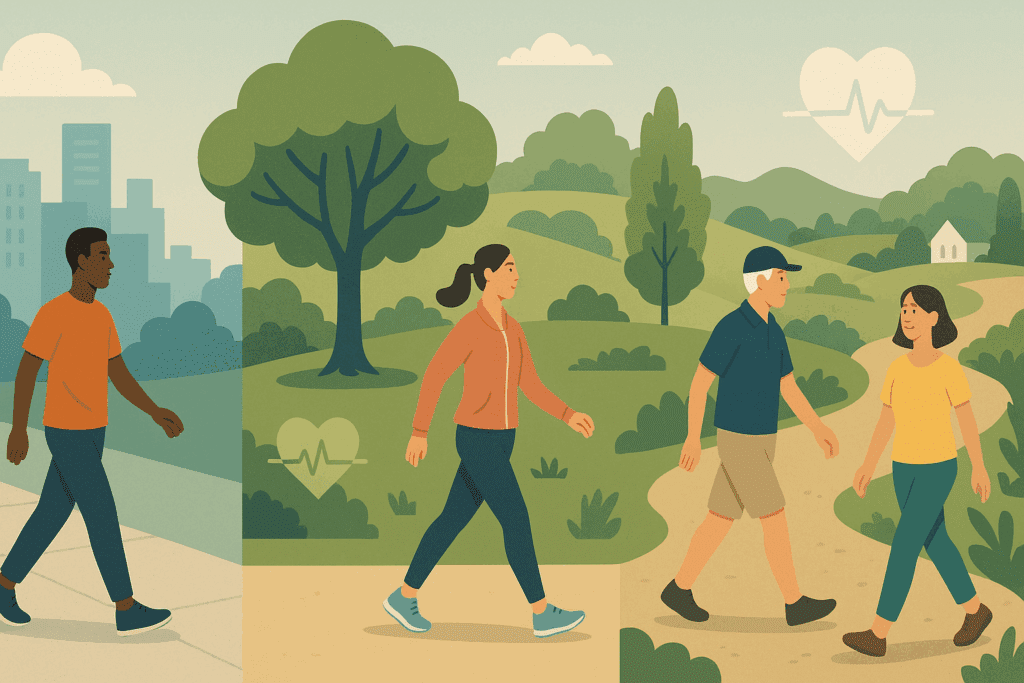Heart disease continues to be the leading cause of death worldwide, responsible for nearly one in every five deaths in the United States alone. Amidst this concerning trend, one powerful yet simple strategy consistently proves effective in reducing cardiovascular risk—walking. Often overlooked in favor of more intense exercise regimens, walking offers a wealth of health benefits, particularly for the heart. But does walking strengthen your heart in a truly measurable way? As it turns out, numerous studies and clinical insights confirm that it does. Walking isn’t just good for general well-being—it directly impacts cardiovascular resilience, helps prevent chronic illness, and plays a key role in the prevention of heart disease.
You may also like: Smart Nutrition Choices for a Healthier Lifestyle: What to Know About Whole Grain Rice and Whole Wheat Rice

The Heart’s Lifelong Ally: Why Walking Matters
The heart is a muscular organ designed to beat continuously—about 100,000 times a day—to circulate blood throughout the body. Like any muscle, it becomes stronger and more efficient with regular use. When you walk briskly, your heart rate rises, your breathing deepens, and your circulatory system is activated. This gentle cardiovascular challenge is enough to improve heart strength and efficiency over time without overexertion or risk of injury.
From a physiological standpoint, walking enhances the heart’s stroke volume—the amount of blood pumped per beat—making circulation more efficient. It also lowers the resting heart rate and improves the overall tone of blood vessels, reducing the likelihood of plaque buildup or arterial stiffness. Medical experts agree that these adaptations help mitigate the development and progression of heart disease, offering a non-invasive and accessible path to prevention. When exploring the connection between walking and heart disease, one finds that consistency is more important than intensity, especially for long-term benefits.

Scientific Proof: How Walking Helps Prevent Heart Disease
The link between walking and heart disease prevention is more than anecdotal. Decades of medical research underscore the strong cardiovascular benefits associated with walking. A landmark study from the Harvard School of Public Health followed more than 70,000 women and found that walking just 30 minutes per day was associated with a 30 to 40 percent reduced risk of coronary heart disease. These results were consistent across age groups and body weights, affirming the universal power of walking for heart protection.
In another large cohort study of over 10,000 male alumni from Harvard University, researchers discovered that walking nine miles per week was enough to lower cardiovascular mortality by 22 percent. Other long-term studies confirm that walking improves cholesterol profiles, lowers blood pressure, and reduces systemic inflammation—key drivers of cardiovascular risk. So when asking, does walking strengthen your heart, the evidence resoundingly supports that it does, offering protective benefits even in modest amounts.
Walking to Control Blood Pressure and Boost Circulation
Hypertension, or high blood pressure, is one of the most significant risk factors for cardiovascular disease. Fortunately, it is also one of the most responsive to lifestyle change. Walking improves circulation and reduces arterial pressure, which in turn helps lower blood pressure levels. Multiple clinical trials have shown that regular walking, especially at a moderate pace, can lower systolic blood pressure by as much as 10 mmHg—a reduction comparable to many prescription medications.
This occurs because walking stimulates the production of nitric oxide, a molecule that helps dilate blood vessels and promote healthy circulation. Over time, this leads to more flexible arteries, less resistance in the vascular system, and a decreased workload on the heart. As circulation improves, oxygen and nutrients are more effectively delivered to tissues, improving not just cardiovascular health, but overall physiological resilience. For individuals already diagnosed with heart disease or hypertension, walking offers a safe and effective way to restore balance and control.

Heart Rate Variability and Stress Reduction: The Holistic Effect of Walking
One of the lesser-known but important benefits of walking is its positive impact on heart rate variability (HRV)—a metric used to gauge autonomic nervous system balance. High HRV is associated with lower risk of cardiovascular events, improved stress resilience, and overall longevity. Walking, especially when practiced consistently in natural settings, improves HRV by shifting the nervous system from sympathetic dominance (the fight-or-flight mode) to parasympathetic dominance (the rest-and-repair mode).
In practical terms, this means walking helps your body recover from stress more effectively and keeps your heart rhythm stable, even under pressure. Stress is an underappreciated contributor to heart disease. Chronically elevated cortisol and adrenaline levels can cause long-term damage to arteries, increase inflammation, and disrupt metabolic health. Walking—especially mindful walking—helps break this cycle. Whether alone in a park or chatting with a friend on a daily stroll, the calming effect of walking extends far beyond physical movement.

Metabolic Benefits of Walking: Weight Management and Blood Sugar Control
Obesity and insulin resistance are two of the most significant contributors to heart disease. Walking plays a powerful role in reducing both. Unlike high-intensity workouts that may not be sustainable for everyone, walking is accessible, safe, and easily integrated into daily life. When practiced consistently, it supports gradual fat loss, particularly in the abdominal region, where excess fat poses the greatest cardiovascular threat.
In addition, walking improves insulin sensitivity and helps regulate blood sugar levels. This is particularly important for individuals with metabolic syndrome or type 2 diabetes, conditions closely linked with cardiovascular events. By improving glucose uptake and reducing reliance on insulin, walking supports long-term metabolic health. These benefits compound over time, making walking a powerful preventive measure against the cascading effects of metabolic and cardiovascular decline.
Walking as Preventive Medicine: Evidence from Public Health Research
From a public health perspective, walking is one of the most cost-effective interventions for preventing chronic disease. Unlike medications or surgeries, walking requires no prescription, no special equipment, and no financial investment. Yet, its impact rivals even the most advanced treatments in terms of outcomes. A meta-analysis of over 400,000 participants found that those who walked regularly had a 31 percent lower risk of cardiovascular mortality and a 27 percent lower risk of all-cause mortality.
Public health guidelines around the world—whether from the American Heart Association, the World Health Organization, or the CDC—consistently recommend walking as part of a heart-healthy lifestyle. This universal endorsement reflects not only the overwhelming scientific support but also the practicality of walking. For individuals of all ages, fitness levels, and medical histories, walking represents a sustainable and scalable form of physical activity that improves heart health without side effects.

Strategies to Make Walking a Lifelong Habit
Knowing that walking and heart disease are closely connected is one thing; turning that knowledge into action is another. For walking to offer its full benefits, consistency is key. Fortunately, creating a walking routine that sticks doesn’t require a dramatic life overhaul. Start by identifying small windows of time in your day—before breakfast, during a lunch break, or after dinner—and dedicate those moments to walking.
Incorporate walking into errands and daily tasks. Park farther from store entrances, take stairs instead of elevators, or walk to nearby appointments. Investing in a good pair of walking shoes and tracking your steps with a wearable device can also add motivation. Research suggests that people who aim for 8,000 to 10,000 steps per day see the greatest reductions in cardiovascular risk.
Walking can also be made more enjoyable and social. Invite a friend or family member to join you. Explore a local nature trail or urban walking tour. Listen to a podcast or uplifting music while you walk. The more engaging your routine, the more likely you are to keep it up. For those with mobility issues or chronic conditions, even short, indoor walks or treadmill sessions can provide measurable benefits and should not be underestimated.
Is Walking Enough Compared to More Intense Exercise?
In the age of high-intensity interval training and competitive fitness culture, many question whether walking is enough to truly make a difference. The answer, according to numerous medical reviews, is yes. While more vigorous exercise offers added cardiovascular benefits, walking provides significant protection against heart disease—especially when practiced regularly. What’s more, walking is far easier to sustain over months and years, which is critical for maintaining results.
This is especially relevant for older adults, people recovering from illness, or anyone new to exercise. Walking offers a low-impact, low-risk entry point that can be gradually intensified. For those looking to enhance cardiovascular conditioning further, incorporating intervals of brisk walking or hill climbing can elevate heart rate and provide an additional stimulus for heart strengthening.
Most importantly, consistency outweighs intensity. A 20-minute walk every day will deliver more benefit than an occasional intense workout followed by long periods of inactivity. Heart health thrives on regular engagement, and walking delivers precisely that in a format that’s realistic and accessible for most people.

How Much Walking Is Required for Heart Benefits?
The American Heart Association recommends at least 150 minutes of moderate-intensity aerobic activity each week—about 30 minutes a day, five days a week. Walking fits this guideline perfectly. Even lower volumes can yield benefits, especially for previously sedentary individuals. One study found that walking just 75 minutes per week reduced heart disease risk, while greater duration or brisker pace led to further gains.
What’s promising is the flexibility. Walking can be broken into smaller increments—three 10-minute walks, for example—and still offer full benefits. Whether it’s a walk to the mailbox or a stroll during a phone call, all movement contributes to cardiovascular health. This adaptability makes walking particularly well-suited to people with unpredictable schedules or energy levels.
Those aiming for additional improvements may benefit from increasing walking speed or duration. Walking at a brisk pace (around 3 to 4 miles per hour) and gradually building up to 10,000 steps per day has been linked to improved VO2 max, lower cholesterol levels, and decreased risk of hospitalization for heart-related conditions. In short, even modest changes in walking behavior can lead to significant long-term health improvements.
Frequently Asked Questions: Walking and Heart Health
1. Can walking improve heart health even if you’re already fit? Yes, walking can significantly enhance heart health regardless of your current fitness level. For individuals who already exercise regularly, walking serves as a recovery activity that supports active circulation and parasympathetic nervous system activation. This contributes to cardiovascular resilience by improving heart rate variability and reducing resting heart rate over time. Even elite athletes can benefit from incorporating walking into their routines to support endurance, reduce inflammation, and lower stress levels—factors that protect long-term heart function. So when considering the question “does walking strengthen your heart,” the answer holds true across all fitness levels, not just for beginners.
2. How does walking differ from running in terms of heart health benefits? While both walking and running improve cardiovascular fitness, walking provides heart health benefits with lower impact and reduced risk of injury. Unlike running, which places more stress on the joints and may not be suitable for everyone, walking is gentle on the body and sustainable over a lifetime. Interestingly, research has shown that walking and running yield comparable reductions in risk for high blood pressure, high cholesterol, and heart disease—when energy expenditure is matched. This highlights why the connection between walking and heart disease prevention is so robust: it’s not about speed, but about consistency and duration. Walking offers a safer, more inclusive alternative without compromising cardiovascular outcomes.
3. Is there a best time of day to walk for heart health? While the benefits of walking are present regardless of timing, walking in the morning may offer unique advantages for heart health. Morning walks help regulate cortisol rhythms and support metabolic activation, which can reduce blood pressure spikes that often occur after waking. Additionally, walking before eating—especially in a fasted state—may enhance fat metabolism, which is linked to improved cardiovascular markers. For those managing stress-related cardiovascular symptoms, evening walks can be equally beneficial by promoting relaxation and helping transition the body into a parasympathetic state before bedtime. No matter the timing, the act itself reinforces the link between walking and heart disease prevention.
4. How do psychological factors influence the heart benefits of walking? Mental and emotional well-being are deeply connected to heart health. Walking helps regulate the stress response system by lowering cortisol and increasing endorphins, which positively affect blood pressure and heart rhythm. People who walk outdoors, particularly in natural environments, often report lower anxiety and improved mood, which supports long-term adherence and adds to the heart-protective effects. Emotional regulation and a sense of control—both enhanced by walking—are essential to reducing cardiovascular disease risk. Thus, asking “does walking strengthen your heart” involves considering not just the physical act, but the psychological and emotional renewal it supports.
5. Can walking help reverse early signs of heart disease? Yes, walking can help improve or even reverse some early indicators of cardiovascular disease. Regular walking has been shown to reduce arterial stiffness, improve endothelial function, and decrease levels of systemic inflammation—all of which are linked to the early stages of heart disease. In individuals with mild hypertension or prediabetes, walking programs can lead to measurable improvements in blood pressure, cholesterol levels, and insulin sensitivity within just a few months. This demonstrates how walking and heart disease outcomes are closely intertwined even at early stages, and why physicians often prescribe walking as part of lifestyle medicine strategies.
6. Are there specific walking techniques that improve heart outcomes more than others? Yes, walking techniques can influence how effectively the activity strengthens the heart. Brisk walking—typically defined as walking at a pace of 3 to 4 mph—offers greater cardiovascular benefits than leisurely walking due to increased heart rate and aerobic intensity. Interval walking, which alternates between fast and moderate paces, can also provide enhanced cardiovascular conditioning. Uphill or incline walking engages more muscle groups and raises heart rate further, increasing calorie expenditure and metabolic demand. These variations offer dynamic ways to deepen the impact of walking on heart function, reinforcing why asking “does walking strengthen your heart” depends partially on how you walk, not just whether you walk.
7. How does walking benefit people with a family history of heart disease? For individuals with a genetic predisposition to heart disease, walking serves as a critical risk-reduction strategy. While family history can increase your baseline risk, lifestyle modifications like regular walking can mitigate the expression of those genetic risks. Studies in epigenetics show that consistent moderate-intensity physical activity influences gene expression in ways that reduce inflammation, improve lipid metabolism, and enhance vascular health. Walking empowers individuals to exert some control over inherited risk factors, making it a particularly important intervention in populations with familial cardiovascular history. The relationship between walking and heart disease is especially powerful for those aiming to proactively offset genetic vulnerability.
8. What role does walking play in cardiac rehabilitation? Walking is foundational in most cardiac rehabilitation programs. After a cardiac event such as a heart attack or bypass surgery, the body requires gradual reconditioning to rebuild cardiovascular strength and tolerance. Walking provides a controlled, low-impact form of exercise that can be easily monitored and scaled according to a patient’s recovery stage. It helps prevent complications, reduces anxiety about movement, and restores confidence while supporting physical healing. This clinical use case strongly supports the broader claim that walking strengthens your heart—it is, quite literally, part of the protocol for heart repair.
9. Can wearable technology enhance the heart health benefits of walking? Absolutely. Wearable fitness devices—such as pedometers, smartwatches, and heart rate monitors—can help individuals track progress, set goals, and maintain consistency in their walking routines. These tools increase awareness of walking frequency and intensity, both of which are essential for maximizing cardiovascular benefits. Some devices even offer real-time feedback on heart rate zones, encouraging users to sustain moderate intensity for optimal heart health. In clinical settings, remote monitoring through wearables is becoming more common for patients with cardiovascular risk. This integration of technology reinforces the practical synergy between walking and heart disease prevention.
10. How might walking evolve as a public health tool for cardiovascular wellness? Looking ahead, walking is likely to gain more attention as a primary preventive strategy in population health models. Urban planning initiatives that prioritize walkable neighborhoods, pedestrian-friendly infrastructure, and accessible green spaces are increasingly recognized as vital to reducing heart disease rates. Healthcare providers are also beginning to “prescribe” walking through structured lifestyle medicine programs, often supported by coaching or mobile apps. As research continues to affirm that walking strengthens your heart, public policy may further evolve to treat walking as a cost-effective intervention with widespread reach. The future of walking and heart disease prevention lies in making movement a default part of daily life—supported not just by personal motivation, but by social and systemic infrastructure.
Conclusion: Walking and Heart Disease—A Natural Prescription for Lifelong Health
So, does walking strengthen your heart? The science says yes—resoundingly, repeatedly, and convincingly. Walking improves cardiovascular function, regulates blood pressure, enhances circulation, supports healthy weight, and even boosts emotional well-being. When evaluating the impact of walking and heart disease, the relationship is not only clear but compelling: walking is one of the most powerful, accessible, and underutilized tools in cardiovascular prevention.
Unlike many health interventions that require cost, equipment, or expertise, walking is free, simple, and safe. It is adaptable to nearly every lifestyle and physical ability, offering a lifelong strategy for preventing heart disease without side effects or limitations. For patients, healthcare providers, and public health experts alike, walking represents a foundational habit that can shift the trajectory of cardiovascular health at both the individual and societal level.
In the end, walking isn’t just about movement—it’s about momentum. Momentum toward better heart health, improved endurance, and a more empowered approach to wellness. Whether you’re starting with five minutes a day or already hitting your step goals, each walk is a step toward a stronger, more resilient heart. So lace up your shoes, head outside, and walk—not just for fitness, but for life.
Was this article helpful? Don’t let it stop with you. Share it right now with someone who needs to see it—whether it’s a friend, a colleague, or your whole network. And if staying ahead on this topic matters to you, subscribe to this publication for the most up-to-date information. You’ll get the latest insights delivered straight to you—no searching, no missing out.
Further Reading:
Walking – the first steps in cardiovascular disease prevention

